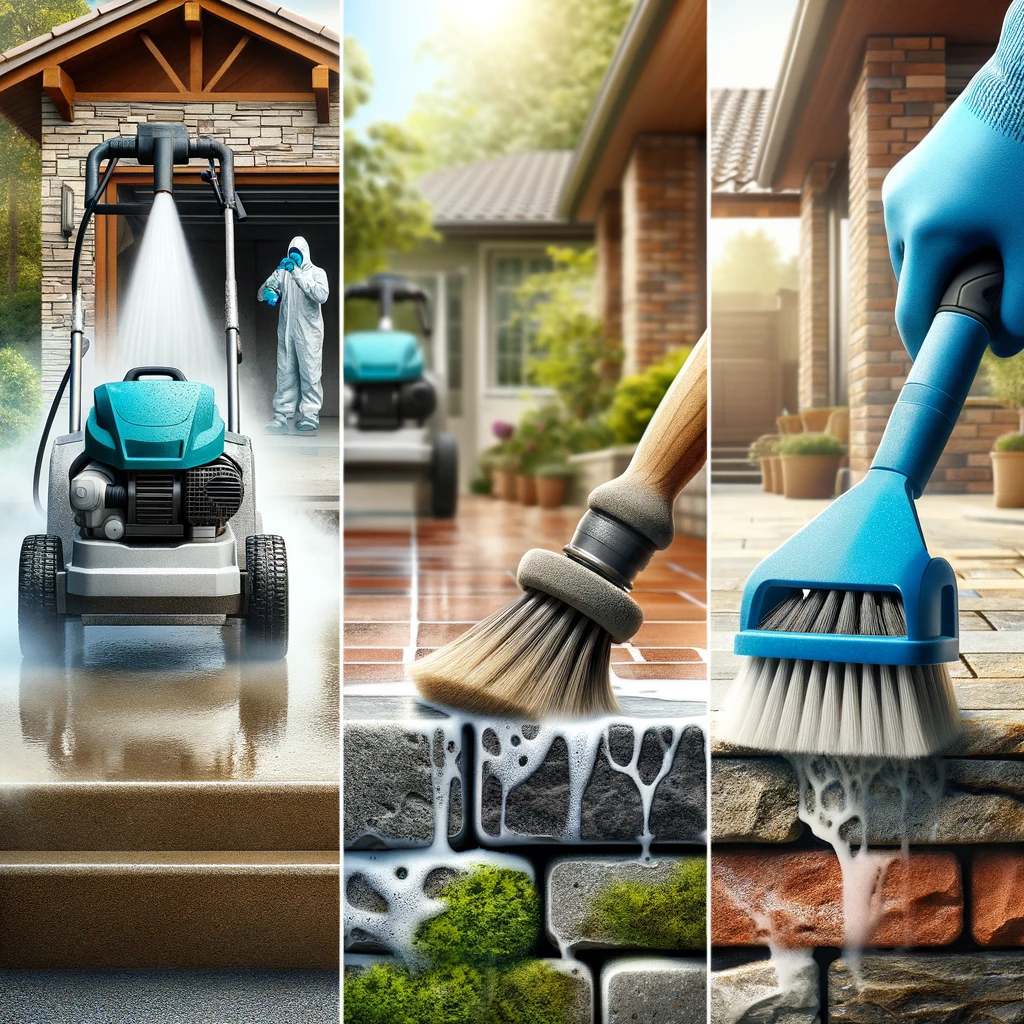A Guide to Cleaning Concrete, Brick, and Stone Exteriors
Maintaining the exterior surfaces of your home or property is essential for both aesthetic appeal and longevity. Concrete, brick, and stone are popular choices for exteriors due to their durability, but they require regular cleaning to keep them looking their best. This guide will walk you through the importance of cleaning these surfaces, the methods and tools you can use, and tips for maintaining their pristine condition.
Importance of Cleaning Concrete, Brick, & Stone Surfaces
- Aesthetic Appeal: Over time, dirt, grime, moss, algae, and other contaminants can accumulate on exterior surfaces, dulling their appearance and making your property look neglected.
- Structural Integrity: Regular cleaning helps prevent the growth of mold, mildew, and moss, which can deteriorate the materials, especially in damp climates.
- Safety: Algae and moss can make surfaces slippery, posing a risk of slips and falls.
- Property Value: A well-maintained exterior enhances the curb appeal and overall value of your property.
Cleaning Methods for Different Surfaces
Each material requires a slightly different approach to cleaning, as the wrong method can cause damage.
1. Concrete Cleaning
Concrete is a durable material, but it's prone to staining, especially in high-traffic areas. Here's how to clean it:
- Pressure Washing: This is the most common method for cleaning concrete. A pressure washer with a PSI between 2500 to 3000 is typically sufficient. Start with a wide spray pattern to avoid gouging the surface.
- Detergents and Degreasers: For oil stains and tough dirt, apply a concrete cleaner or degreaser. Let it sit for a few minutes before scrubbing with a stiff brush and rinsing.
- Mold and Mildew Removal: Use a solution of bleach and water (1:10 ratio) to kill mold and mildew. Apply it with a garden sprayer, let it sit for 10 minutes, then scrub and rinse thoroughly.

2. Brick Cleaning
Brick surfaces are porous and can accumulate moss, mildew, and efflorescence (white mineral deposits). Cleaning brick requires a gentle touch:
- Low-Pressure Washing: Use a pressure washer with a PSI between 500 to 1000 to clean brick. High pressure can damage the mortar joints.
- Mild Detergents: Use a mild detergent mixed with water to scrub the bricks with a soft-bristle brush. Avoid acidic cleaners as they can erode the bricks.
- Efflorescence Removal: To remove efflorescence, use a mixture of equal parts white vinegar and water. Apply it with a brush and rinse thoroughly.
- Moss and Algae Removal: Use a non-toxic moss and algae cleaner to avoid damaging the brick and surrounding vegetation.
3. Stone Cleaning
Natural stone surfaces, such as granite, limestone, or slate, are prone to discoloration and staining. The cleaning process depends on the type of stone:
- Pressure Washing: Similar to brick, stone surfaces should be cleaned with a low-pressure washer to avoid surface damage.
- pH-Neutral Cleaners: Use pH-neutral cleaners specifically designed for stone surfaces to avoid chemical reactions that can etch or stain the stone. Avoid acidic or alkaline cleaners.
- Poultices for Stains: For stubborn stains, apply a poultice (a paste made of a cleaning agent and an absorbent material like baking soda) to draw out the stain. Let it dry, then rinse.
- Sealing: After cleaning, consider sealing the stone to protect it from future staining and weather damage.
Tools and Equipment
Here's a list of essential tools and materials you might need:
- Pressure Washer: Adjustable PSI settings are ideal for different surfaces.
- Garden Hose: For rinsing surfaces and diluting cleaning agents.
- Scrub Brushes: Soft-bristle brushes for delicate surfaces and stiff brushes for concrete.
- Cleaning Solutions: Specific cleaners for mold, mildew, and efflorescence.
- Protective Gear: Gloves, safety goggles, and a mask to protect yourself from chemicals and debris.
- Sealers: For stone surfaces, to enhance durability and appearance.
Tips for Maintaining Clean Surfaces
- Regular Cleaning: Schedule routine cleaning to prevent the buildup of dirt, moss, and mildew.
- Inspect for Damage: Regularly check for cracks, loose mortar, or damaged stone, and repair promptly to avoid more extensive damage.
- Use Environmentally Friendly Cleaners: Opt for eco-friendly cleaning solutions to protect your landscaping and the environment.
- Seal Porous Surfaces: Seal brick and stone surfaces periodically to protect against water infiltration and staining.
- Seasonal Maintenance: Clean surfaces at least twice a year, particularly in the spring and fall, to remove winter grime and prepare for seasonal changes.
Conclusion
Cleaning and maintaining the concrete, brick, and stone surfaces of your property is crucial for preserving their beauty and longevity. By using the right techniques and tools, you can keep these materials in excellent condition, ensuring that your property remains safe, appealing, and valuable. Regular maintenance not only saves you time and money in the long run but also enhances the overall enjoyment and pride in your home or business.
 Cleaning Services
Cleaning Services